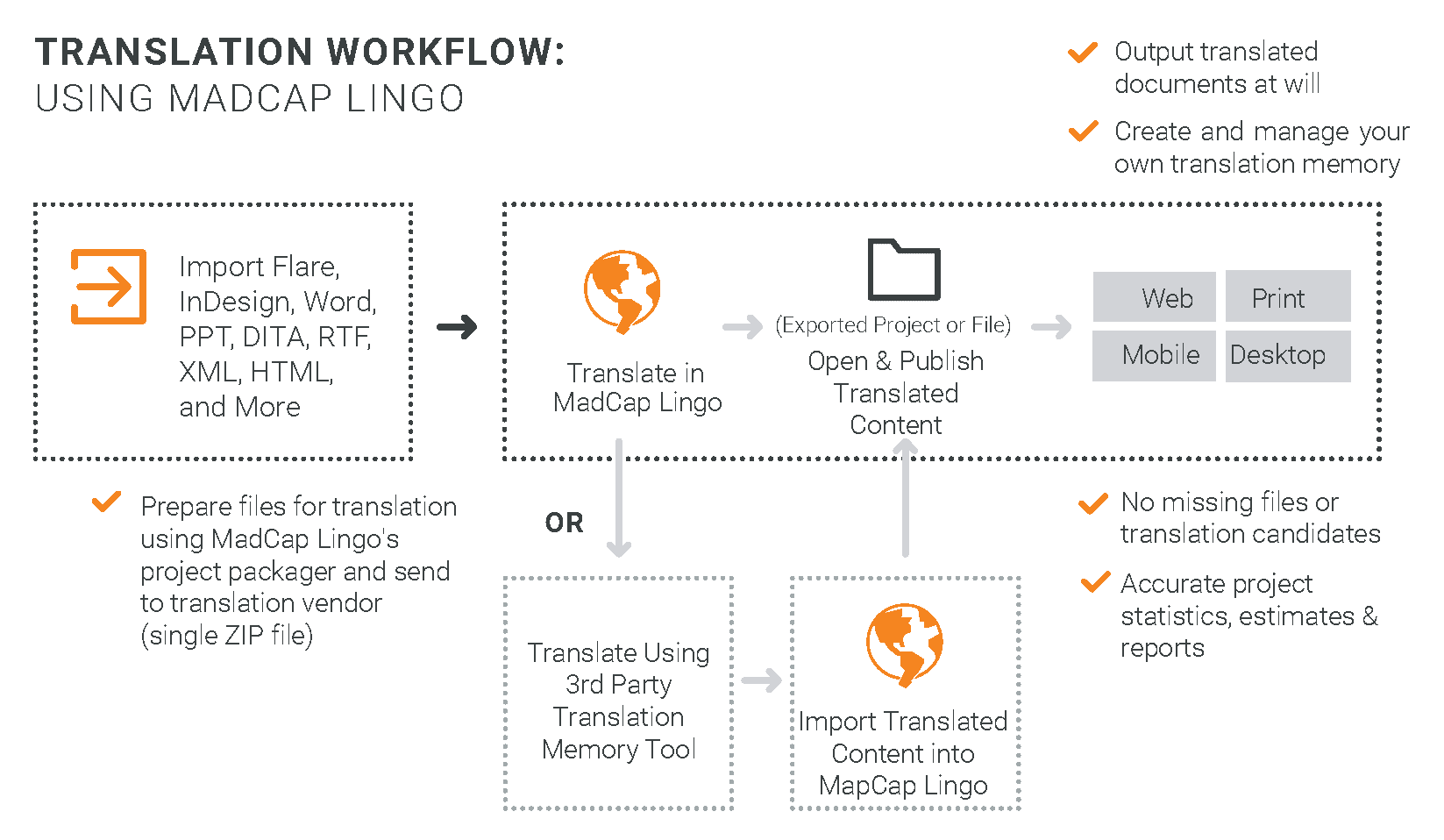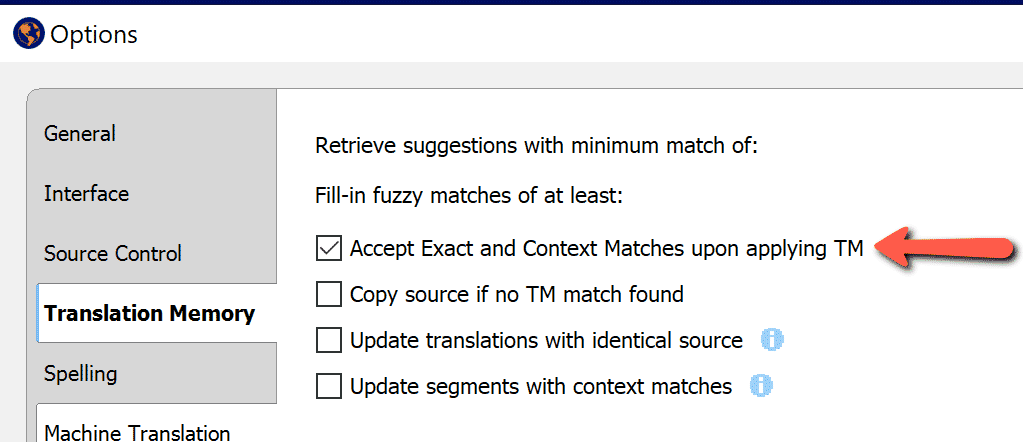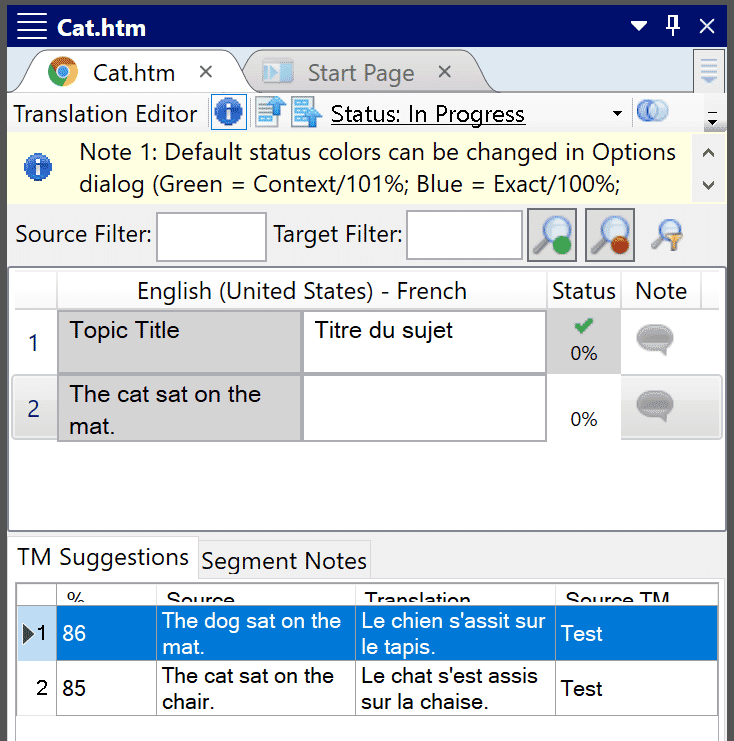Exploiting Translation Memory with MadCap Lingo
Matthew Ellison provides tips on how to reduce your translation costs.
Within an increasingly global market, many software companies need to translate the documentation and supporting Help for their products into a range of different languages. This can be time-consuming and costly — in some cases, far more expensive than the development of the source documentation in the original language.
Whether you translate your MadCap Flare projects in-house, or you send them for translation by third-party translation companies, MadCap Lingo can play a potentially useful and cost-saving role in the process, mainly through its support for Translation Memory (TM).
Background on MadCap Lingo
Lingo is a self-contained product from MadCap Software that helps with the translation of MadCap Flare projects, Doc-To-Help projects, XML files, and documents in a range of formats including Microsoft® Word. It can be used in two different ways:
- For translation within Lingo, as an alternative to translation tools such as Trados or memoQ. Translators enter the translated text for each segment alongside the source language within Lingo’s Translation Editor.
- As an interface between Flare or Doc-To-Help and third-party translation companies. Lingo identifies the files that require translation, converts them to XLIFF (XML Localization Interchange File Format), a standard format used by translators, and then you send these files to the translation company as a zipped ‘Translation Bundle’. The translation company then sends back the translated bundle, which you merge back into the Lingo project.
In both cases, it is possible to handle multiple target languages within the same Lingo project. Figure 1 illustrates the two possible workflows.

Figure 1: Lingo Workflow
Having got the translated content for the required target languages in Lingo, you then export back to a new Flare project for each of those languages.
The rest of this article focuses on how you can save time and money by taking control of your TM and exploiting it to the full.
Introduction to TM
Translation Memory is the key to minimizing your translation costs. It works by remembering any previous translations of all segments (sentences), meaning that if a document contains a sentence that has already been translated, that sentence can be automatically translated at minimal (or potentially zero) cost (and minimal risk of context ‘clashes’ - see below).
Segments to be translated are compared against segments in TM, and a percentage match is assigned to each one. This percentage indicates how closely the segment to be translated matches a segment that has previously been translated. For example, 0% means there is no matching segment in TM, 70% means that there is a segment that is close (but not an exact match), and 100% means that there is a segment that is an exact word-for-word match.
You might expect from a mathematical perspective that 100% was the highest possible match, but in fact, this is not the case! A match of 101% means that not only is there an exactly matching segment, but its context (the segment before or after it) is also an exact match — this indicates that you can have increased confidence in the matching translation.
Using TM With Lingo
In Lingo, you control your TM. When you create a Lingo project, you can associate it with a translation memory database. This gives you an immediate benefit because all segments within the project will automatically be matched against that TM. There is an option that enables you automatically to accept 100% and 101% matches (see Figure 2), and that can immediately reduce the amount of translation work that needs to be done.

Figure 2: Accept Exact and Context Matches
Translating Within Lingo
TM saves you time by helping you in the following ways when you are translating within Lingo:
- You do not need to open the topics that have been Completed (due to the fact that all their segments have an exact match with segments in TM).
- When you are translating a topic, translations for segments with a 100% match are filled in automatically.
- If there is no exact match, but there are one or more segments in TM with a 50% or higher match, translation for these segments are shown within the TM Suggestion tab at the bottom of the Translation Editor (see Figure 3). You can choose one of these segments, and then edit the translation to make it accurate for the current segment.

Figure 3: TM Suggestions
Working with Translation Companies
When translation companies translate content for you, they always create and use TM in order to save time and work more efficiently. However, unless they send you this translation memory in the form of a Translation Memory eXchange (TMX) file, you don’t always receive the benefit from it. For example, if you had not received any TMX files and you then changed translation companies, the new company would need to start translating from scratch without the benefit of any TM. This means that you are paying full price for the translation of segments that have been previously translated by a different company.
Using Lingo, however, you always have your own copy of the TM. This is because, when you merge a translated Bundle back into Lingo, all the translations made by the translation company are automatically uploaded to your own TM database. For future translations, you can automatically translate documents from your own copy of the TM, and then send for translation only those content items that have not been automatically completed by Lingo. You can do this easily by deselecting the Completed status in the Create Bundle dialog (see Figure 4).

Figure 4: Create Bundle Dialog
Conclusion
Using Lingo within your translation workflow gives you control of your TM and saves you costs for both in-house and third-party translations. It also provides valuable insurance against losing your TM in the case of switching to a new translation company and means that you should normally only have to send for translation, new content that has not previously been translated.

About the Author
Matthew Ellison
Matthew Ellison runs UA Europe, an independent UK-based company that specializes in user assistance design and development. He has over 30 years of experience as a user assistance professional, including a period in the US as Director of the WritersUA Conference. Matthew is a MadCap Flare Certified Instructor and regularly presents training on Flare for students in Europe and other parts of the world. He is a past winner of the Horace Hockley award that is presented annually by the Institute of Scientific and Technical Communicators (ISTC).
Related Reading
All references accessed 1 February 2021.
- MadCap Lingo’s Help on Translation Memory: https://help.madcapsoftware.com/lingo11r2/Content/Lingo/Translation-Memory/Translation-Memory.htm
- Which Should You Trust More, the Machine or Your Fuzzy Translation Memory? (Blog post by Scott Bass on MadCap Software website): www.madcapsoftware.com/blog/which-should-you-trust-more-the-machine-or-your-fuzzy-translation-memory/
- What is Translation Memory? (Pangeanic translation company): https://pangeanic.com/knowledge/what-is-translation-memory
- Ultimate Guide to Translating your MadCap Flare Projects (Advanced Language Translation Inc.): http://cdn2.hubspot.net/hub/289455/file-1348194724-pdf/Ultimate_Guide_to_MadCap_Flare_Translation.pdf
- A Guide to Starting Translation With MadCap Flare (Monika Bujanowicz, ATL translation company): www.atltranslate.com/articles/translation-madcap-flare-tips




